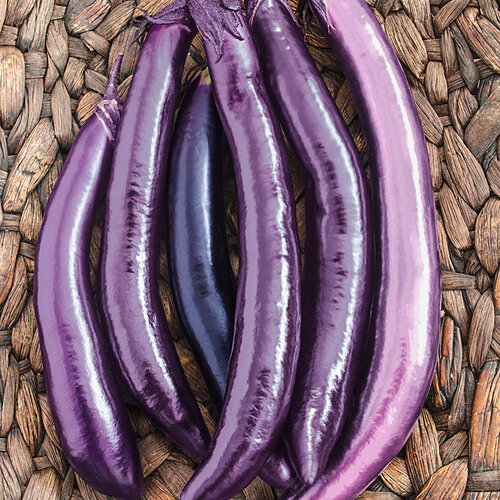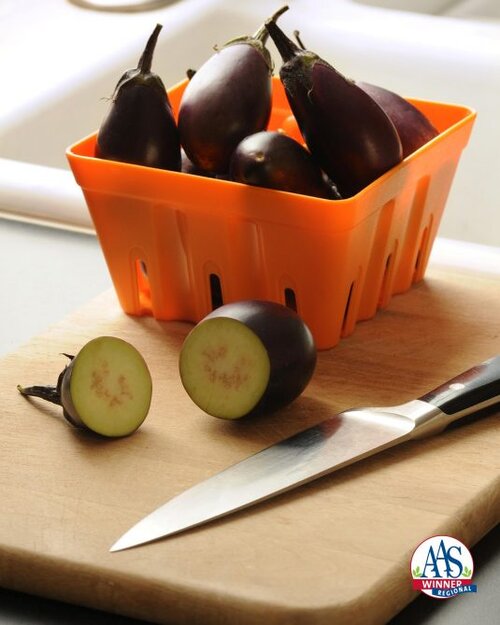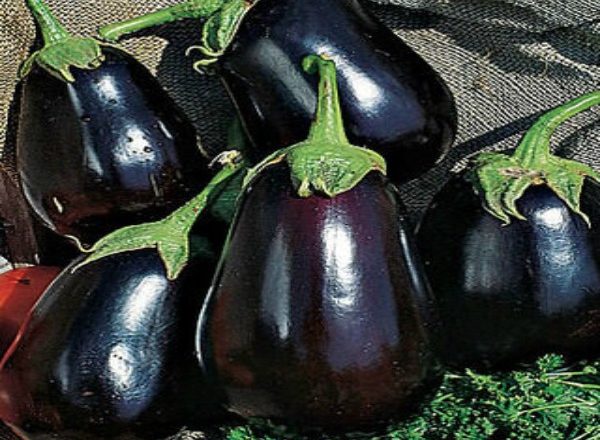Eggplants come in all shapes and sizes, from mammoth 3-pounders to long, slender Asian types, to baby patio varieties. Which type is best suited for your garden depends on your region, your growing conditions, and of course your taste preferences.

Left: ‘Black Beauty’ is a typical “Italian” type eggplant, with large fruits averaging about 2 pounds that grow on plants that are about 2 feet in height. Considered an early maturing variety, fruits ripen about 70 days after transplanting. This type of large eggplant is best grown in regions that have a long growing season.
Center: ‘Ping Tung Long’ is a very productive representative of Asian varieties, though in fact this type of eggplant comes in a variety of colors: near black, green, all shades of purple, and even white. ‘Ping Tung’ fruits can be 12 inches or longer; plants grow to about 3 feet in height and bear fruit about 70 days from harvest. Asian varieties are easy to grow in most regions.

Right: ‘Patio Baby’ is very early, with baby sized 2 to 3 inch fruits. The plant grows to about 18 inches and yields 25 to 50 fruits per plant. Small eggplants such as ‘Patio Baby’, ‘Bambino’, ‘Little Prince’, and ‘Fairy Tale’ can start producing fruit in as little as 45 days from transplanting, which makes them good choices for northern growers. Provide a large container for patio eggplants, and fertilize the plants regularly.

Step-by-Step
- Start seed indoors about 2 months before your planting date. Sow seeds ¼ inch deep and 1 inch apart, and keep the soil warm, using a heat mat if necessary. Provide a strong light source, and fertilize seedlings every two weeks with half strength liquid fertilizer.
- Transplant seedlings into larger containers to keep them growing vigorously until it is time to plant them in the garden.
- Bring your seedling pots outside on sunny days when daytime temperatures warm to 75°F.
- Hold off on planting eggplants in the soil until nighttime air temperatures are reliably in the 50°F range.
- Fertilize regularly throughout the season.
- Harvest eggplants when the fruits are firm and glossy. If you wait too long, the skin will turn dull and the flesh will acquire a bitter flavor.
What You Need To Know
Eggplants love heat. There’s nothing to be gained by rushing them into the ground before the nighttime temperatures are at or above 50°F.
Expect Flea Beetles. Your best defense against this pest is allowing your plants to get big and healthy before planting them out, which means transplanting small seedlings into larger pots and fertilizing them every other week. When plants are vigorous from the start, they won’t be set back by the inevitable flea beetle leaf holes.
Different types of eggplants are best suited for different uses. If you’re looking to make eggplant parmesan or grilled eggplant slabs, use meaty slices of “Italian” type eggplants.

Long, skinny eggplants are perfect for stir-frying, as their thin skins don’t need to be peeled.

White eggplants are a little more delicate in flavor than most other types, so if bitter is not your thing, try these. Small patio eggplants can be grilled and sautéed.
All types of eggplants are delicious sliced and roasted. Simply brush ½ inch slices with olive oil, sprinkle with salt, and roast in a 400° oven.

source : Home Garden



